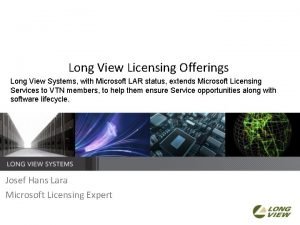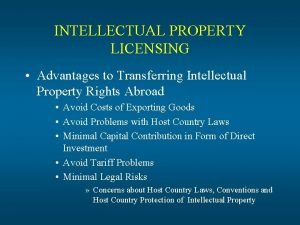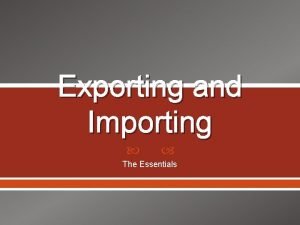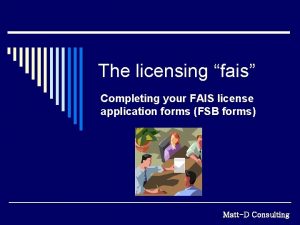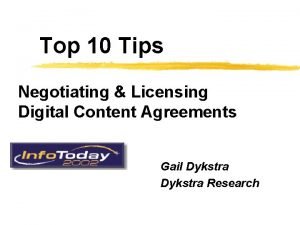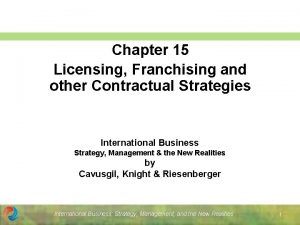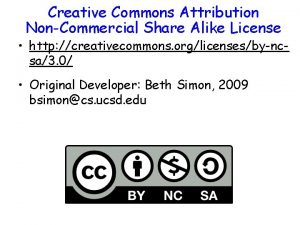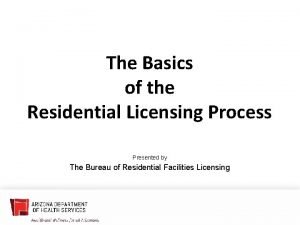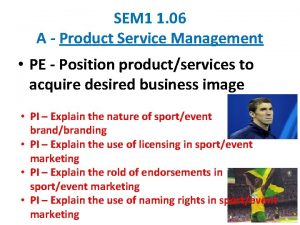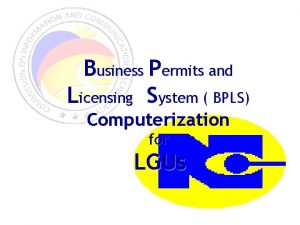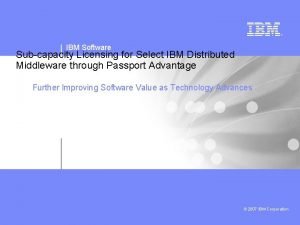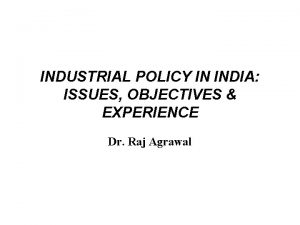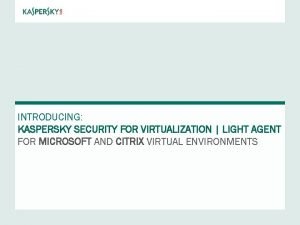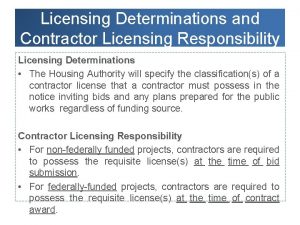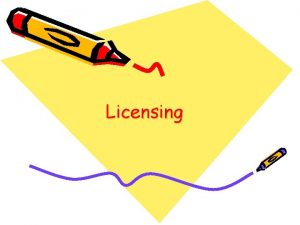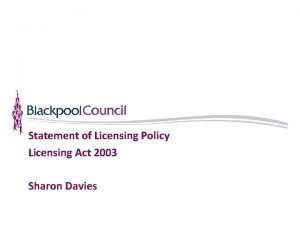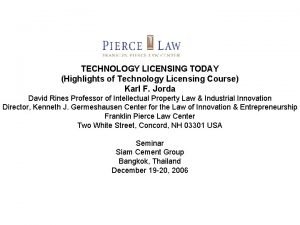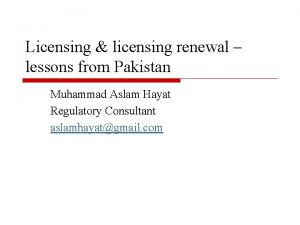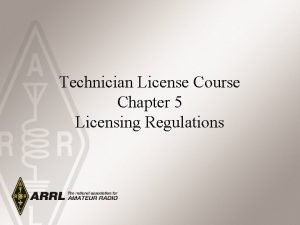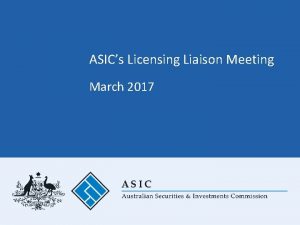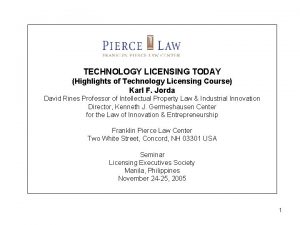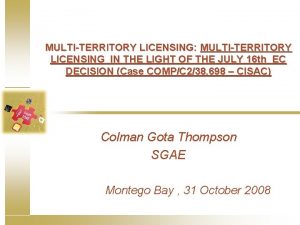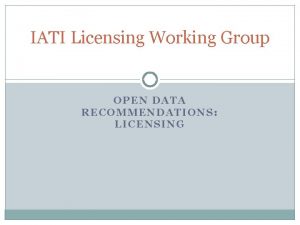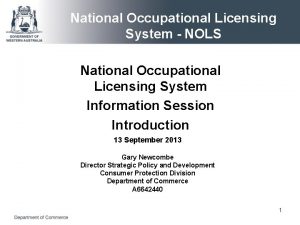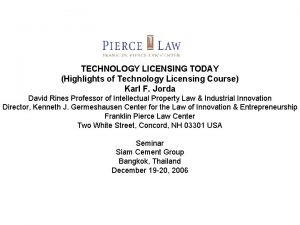Lecture 5 Licensing Outline What is Licensing When































- Slides: 31

Lecture 5 Licensing

Outline § § What is Licensing? When is it employed? Licensing related issues Elements of License Agreement Trademark and brand licensing Ø Several Trends § Some Cases

Contractual Relationships are Fairly Common § Pharmaceutical firms engage in cross-licensing practices in which they exchange scientific knowledge about producing products and distribution rights. § Service firms in retailing, fast food, car rentals, television programming, and animation rely on licensing and franchising agreements. § 7 -Eleven is the world's largest chain of convenience stores, with about 26, 000 stores in 18 countries. While the parent firm in Japan owns most of the stores, several thousand in Canada, Mexico, and the U. S. operate via licensing or franchising agreements.

What is Licensing? § Licensing is a contractual arrangement whereby the licensor (selling firm) allows its technology, patents, trademarks, designs, processes, know-how, intellectual property, or other proprietary advantages to be used for a fee by the licensee (buying firm). § It is a strategy for technology transfer. § Franchising is an organizational form where the franchisor of a service, trademarked product, or brand name allows the franchisee to use the same in return for a lump sum payment and/or royalty, while conforming to required standards of quality, service, and so forth.


When is Licensing employed? ▲ From the perspective of the licensor: 1. A firm lacks the capital, managerial resources, or knowledge of foreign markets required for exporting or FDI, but it wants to earn additional profits with minimal commitment. 2. Licensing is a way of testing and proactively developing a market that can later be exploited by direct investment. 3. The technology involved is not central to the licensor's core business. Not surprisingly, single-or dominant-product firms are very reluctant to license their core technology, whereas diversified firms are much more willing to license peripheral technologies.

When is Licensing employed? 4. Prospects of "technology feedback" are high (i. e. , the licensor has been contractually ensured of access to new developments generated by the licensee and based on licensed knowledge). 5. The licensor wishes to exploit its technology in secondary markets that may be too small to justify larger investments; the required economies of scale may not be attainable. 6. Host-country governments restrict imports or FDI, or both; or the risk of nationalization or foreign control is too great. 7. The licensee is unlikely to become a future competitor. 8. The pace of technological change is rapid that the licensor can remain technologically superior to the licensee. If the technology may become obsolete quickly, there is pressure to exploit it fully while the opportunity exists.

When is Licensing employed? ▲From the perspective of the licensee: § The main advantage of licensing is that the licensee's existing products or technology can be acquired more cheaply, faster, and with less risk from third parties (licensors) than by internal R&D. § Another advantage is that the licensee can gain product designs for a desired diversification, to complement other assets it possesses such as production or marketing capability.

Motivations 1. Marketing Motivations 2. Financial Motivations Make money Grow the business Help financial flexibility Roost stock price 3. Strategic Motivations Reduce barriers to entry Test relationships Manage resources and stay foucsed Expand into new territories Technological leadership

Licensing Process

Licensing Related Issues 1. Risks Dissipation of proprietary advantage Tarnishing of reputation due to lack of quality Profits may not be maximized indirect involvement in the licensed markets is exchange rates changes some limitation of the amount of outward payments for licenses ④Difficulty in enforcement of license terms guaranteeing flowback of actual improvements sublicensing diligence that the terms are being honored quality control

Licensing Related Issues 2. Intellectual Property Rights Types of Intellectual Property Ø Patent Ø Trademark Ø Copyright Ø Industrial Design Ø Trade Secret Ø Collective Mark

Licensing Related Issues 2. Intellectual Property Rights Ø In many countries, IP legislation either does not exist or is not enforced Ø Reluctant Licensing: some companies have deemed it necessary to enter into license agreements as a means of offsetting trademark piracy Ø There are numerous implications with such a scenario. E. g. Many organizations are feeling pressure to internationalize their operations sooner than they were expecting. As a consequence, they view licensing as a defensive solution, rather than an opportunity.

Licensing Related Issues 3. Costs of Licensing ØIndirect Costs: Communications, Seeking costs, Monitoring costs, Negotiating costs ØDirect Costs Raw materials, Machines, Warehouses, Labor, R&D

Licensing Related Issues 3. Costs of Licensing § Protection of industrial property § Establishing the license agreement including expenses for searching for suitable licensees, communication, training, equipment testing § Maintaining the license agreement including backup services for licensees, audit, ongoing market research

Licensing Related Issues 4. Unattractive markets for Licensing § Regulatory scheme governing licensing e. g. In France, Ireland Spain, licenses are not valid until government approval or registration is completed. § Restrictions imposed on duration and exclusive rights to territories § Foreign exchange controls and tax on royalty fees e. g. In Europe, the combined withholding tax and VAT(valueadded tax) can range up to about 50%

Elements of License Agreement 1. A clear and correct description of the parties to the agreement 2. A preamble or recitals describing the parties, their reasons for entering into the arrangement, and their respective roles. 3. A list of defined terms for the purposes of the particular contract to simplify this complex document and to eliminate ambiguity. 4. A set of schedules, in an exhibit or appendix, where necessary, to segregate lengthy detailed descriptions of any kind. 5. Explicit description of the grant that is fundamental to the agreement and the nature of the rights being granted to the licensee. 6. Description of any geographical limitations on the licensee’s manufacturing, selling, or sublicensing activities.

Elements of License Agreement 7. A description of any exclusive rights to manufacture and sell that may be granted. 8. A discussion of any rights to sublicense. 9. The terms relating to the duration of the agreement and its extension or review. 10. Provisions for the granting of rights to downstream refinements or improvements made by the licensor in the future. 11. Provisions for “technological flowback” agreements. 12. Details regarding the royalties or periodic payments based on the use of licensed rights. 13. Specification of minimum performance requirements and other protection clauses

International Licensing is Fairly Common § Peter Paul Mounds and Almond Joy are owned by the British food firm Cadbury Schweppes and produced in the U. S. via a licensing agreement with Hershey Inc. § Planters, Sunkist, and Budweiser are owned by U. S. firms and sold in Britain and Japan via licensing agreements with local firms. § Coca-Cola has a licensing agreement to distribute Evian bottled water in the U. S. on behalf of the brand’s owner, French company Danone. § A review of 120 of the largest multinational food companies revealed that at least half are involved in some form of international product licensing.


Mass licensing of software § Mass distributed software is used by individuals on personal computers under license from the developer of that software. Such license is typically included in a more extensive end-user license agreement (EULA) entered into upon the installation of that software on a computer. Typically, a license is associated with a unique code, that when approved grants the end user access to the software in question. § Under a typical end-user license agreement, the user may install the software on a limited number of computers. § The enforceability of end-user license agreements is sometimes questioned.

Trademark and brand licensing § A licensor may grant permission to a licensee to distribute products under a trademark. With such a license, the licensee may use the trademark without fear of a claim of trademark infringement by the licensor. § The assignment of a license often depends on specific contractual terms. The most common terms are, that a license is only applicable for a particular geographic region, just for a certain period of time or barely for a stage in the value chain. § Moreover there are different types of fees within the trademark and brand licensing. The first form demands a fee independent of sales and profits, the second type of license fee is dependent on the productivity of the licensee.

Artwork and character licensing § A licensor may grant a permission to a licensee to copy and distribute copyrighted works such as "art" (e. g. , Thomas Kinkade's painting "Dawn in Los Gatos") and characters (e. g. , Mickey Mouse). With such license, a licensee need not fear a claim of copyright infringement brought by the copyright owner. § Artistic license is, however, not related to the aforementioned license. It is a euphemism that denotes approaches in art works where dramatic effect is achieved at the expense of factual accuracy.

Several Important Trends in Brand Licensing 1. Licensing programs are becoming more deliberate, more strategic and more tailored. 2. Royalty spreads grow, driven by conflicting forces. 3. Professional development: as the business moves into the mainstream of corporate life and reveives attention from higher levels of management, true professionals are starting to take charge and being positioned in top management racks.

Several Important Trends in Brand Licensing 4. Retail partnerships: in face of retail consolidation, where there are fewer buyers, engineering a real constructive partnership between licensor, licensee, and retailer/distributor will become increasingly essential as competition among licensed brands intensifies. 5. Ingredient co-branding: unless they pair-up the name with its necessary ingredient or brand attribute that makes the brand unique, a pure brand license deal will be less powerful. 6. Precursor to mergers and acquisitions: a growing number of merger and acquisition executives view licensing as a means of testing the chemistry between two companies to avoid some of the more common dangers.

Several Important Trends in Brand Licensin 7. Licensing as a competitive weapon: one is oriented to preempting competition by getting into attractive new business before others can; another is to battle comeptition for retail space. 8. Licensing in emerging markets: India and China. 9. More emphasis on product emphasis: more brand owners and their licensing agents are now conducting factory audits on licensees' manufacturing facilities with specific actions requied prior to granting the license and periodic audits conducted randomly throughout the licensing term.

Shanghai Licensing Pavilion

Some Cases ▲ Licensing is a method of entering a foreign market in which the company enters into an agreement with a licensee in the foreign market. Tokyo Disneyland Resort is owned and operated by the Oriental Land Company (a Japanese development company), under license from the Walt Disney Company, headquartered in the United States.

Some Cases LG Fashion, one of the largest fashion companies in South Korea, has successfully built an outdoor apparel and footwear business through brand licensing with Lafuma, a French company that specializes in outdoor apparel, equipment, and footwear. The licensing program worked well for both parties and Lafuma assigned its trademark rights in South Korea to lits licensee, LG Fashion in July 2009. Such License-to-Own (LTO) licensing deal are not common in the U. S. or in Europe, but the LTO strategy provides strong incentives to Asian licensees to invest heavily upfront in the brand, and to treat the brand with the level of dedication and are as if it were their own.

Some Cases Roto-Rooter Corporation, this service franchise which markets drain clearing and plumbing services nationwide, is licensing its name into a line of drain-clearing chemicals. Do they do this to put their franchisees out of business? No, they do it to stay "top-of -mind" with consumers who first dive under their kitchen sink when searching for a drain clearing solution. Once there, they find the Roto-Rooter chemical and, if it doesn't solve their problem, they reach for the phone and call the toll-free 800 number listed on the package for a Roto-Rooter technician. This helps to keep them from searching elsewhere for a plumber.

Some Cases Some American iconic brands such as Westinghouse, have already licensed its brand to a number of Asia-based manufacturers. Westinghous, a wellknown manufacturers of dishwashers, fridges, freezers, ovens, cooktops, rangehoods, washers and dryers, has licensed small kitchen appliances, air purifiers and many other household products have been marketed in China, Russia, Middle East and South America. Hon Kong-based Techtronic Industries Ltd has licensed the Ryobi and RIDGID brand for power tools, and they've successfully bought the licensed products directly into large US retailers, thus eliminating the role of the traditional U. S. licensee, leaving better margins for retailers, the licensees and the brand owners.
 01:640:244 lecture notes - lecture 15: plat, idah, farad
01:640:244 lecture notes - lecture 15: plat, idah, farad Lecture outline example
Lecture outline example Lecture outline example
Lecture outline example Lecture outline meaning
Lecture outline meaning Lecture outline example
Lecture outline example Bread sentence
Bread sentence Railway land license fee
Railway land license fee Mvls licensing
Mvls licensing Advantages of intellectual property
Advantages of intellectual property Exporting office essentials
Exporting office essentials Fais forms
Fais forms Digital content licensing
Digital content licensing Health product site licensing
Health product site licensing Licensing franchising and other contractual strategies
Licensing franchising and other contractual strategies Creative commons attribution share alike
Creative commons attribution share alike Azdhs residential licensing
Azdhs residential licensing Explain the use of licensing in.sport/event marketing
Explain the use of licensing in.sport/event marketing Bpls system
Bpls system Office 365e365
Office 365e365 Ibm sub capacity licensing
Ibm sub capacity licensing Microsoft spla reporting software
Microsoft spla reporting software Wi ems elicensing
Wi ems elicensing Industries requiring compulsory licensing *
Industries requiring compulsory licensing * Kaspersky security for virtualization
Kaspersky security for virtualization Industrial licensing policy 1991
Industrial licensing policy 1991 Licensing and regulation division
Licensing and regulation division Penn state.qualtrics
Penn state.qualtrics Georgia child care licensing regulations
Georgia child care licensing regulations Eopen licensing
Eopen licensing Umw book store
Umw book store Azdhs residential licensing
Azdhs residential licensing Health standards louisiana
Health standards louisiana







